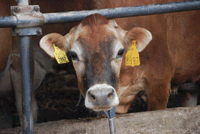Manage ration starch and fiber digestibility levels to achieve optimum efficiency.
With corn prices bumping against $8.00 a bushel and uncertainty surrounding forage availability this year, everyone is looking at ways to cut costs and save money. But instead of pulling ration ingredients for cost cutting sake, Kevin Leahy, nutritionist and technical services manager with Calibrate® Technologies says zeroing in on rumen degradable starch and neutral detergent fiber digestibility levels may be a better solution that offers valuable savings.

Rumen degradable starch
Determining the rumen degradable starch content lets you see how much starch is digested where it matters most - in the rumen. While crude starch guidelines are helpful in formulating dairy rations, identifying ruminal starch digestibility delivers better insights for more informed decisions.
"If the rumen degradable starch test comes back high, this means the cow can access more energy from the feedstuffs," says Leahy. "In the case of corn silage, if the starch level is high, the amount of corn fed could be reduced and the dry matter pounds replaced with a less expensive ingredient like soy hulls, citrus or beet pulp."
Fiber digestibility
Knowing the fiber digestibility of a ration can help determine how quickly feed ingredients are passing through the rumen. Leahy explains, "If the fiber digestibility comes back high, for the forages in a dairy ration, you likely have a high rate of passage of materials through the rumen. You could actually improve feed efficiency by slowing down this rate of passage by feeding some ingredients with lower (slower) digestibility."
At some point this year, dairy producers may run low on alfalfa. "If you know the fiber digestibility of the available alfalfa and you know the fiber digestibility of say wheat straw, there may be a certain amount of replacement you can do, depending upon the numbers," he says. "In some instances we've been able to replace 2 to 3 pounds of dry matter from alfalfa with wheat straw." Leahy reminds producers that they will likely have to make up the decrease in metabolizable protein when making this substitution.
Put this information to work
Recently, Leahy worked with a herd to put ruminal starch and fiber digestibility scores to work in reducing its ration cost. Based on the rumen degradable starch and fiber digestibility tests, this herd realized it could safely remove 2.5 pounds of corn from the ration, replacing much of it with corn silage. With corn at $285 per ton, that was a 36 cent savings.
Of course the 2.5 pounds of dry matter had to be replaced by other ingredients. "If the replacement ingredients cost two-thirds of what was saved, it would still be a savings of 12 cents per cow per day. On a 1,000 cow dairy, that's a $120 per day savings," he explains.
 "When looking to cut costs, don't overlook the power of understanding ruminal starch and fiber digestibility and the opportunity it could offer to reduce ration costs," says Leahy.
"When looking to cut costs, don't overlook the power of understanding ruminal starch and fiber digestibility and the opportunity it could offer to reduce ration costs," says Leahy.For more information on ruminal starch digestibility contact Kevin Leahy by Ph: (636) 742-6275, email: KTLeahy@calibratetechnologies.com or go to: www.calibratetechnologies.com.
Calibrate® Technologies provides the dairy industry's first rapid starch and fiber test with an online nutritional calculator to help provide ration recommendations to nutritionists and producers on rumen digestibility of forages and feedstuffs. For additional information, visit www.CalibrateTechnologies.com
09.19.2012